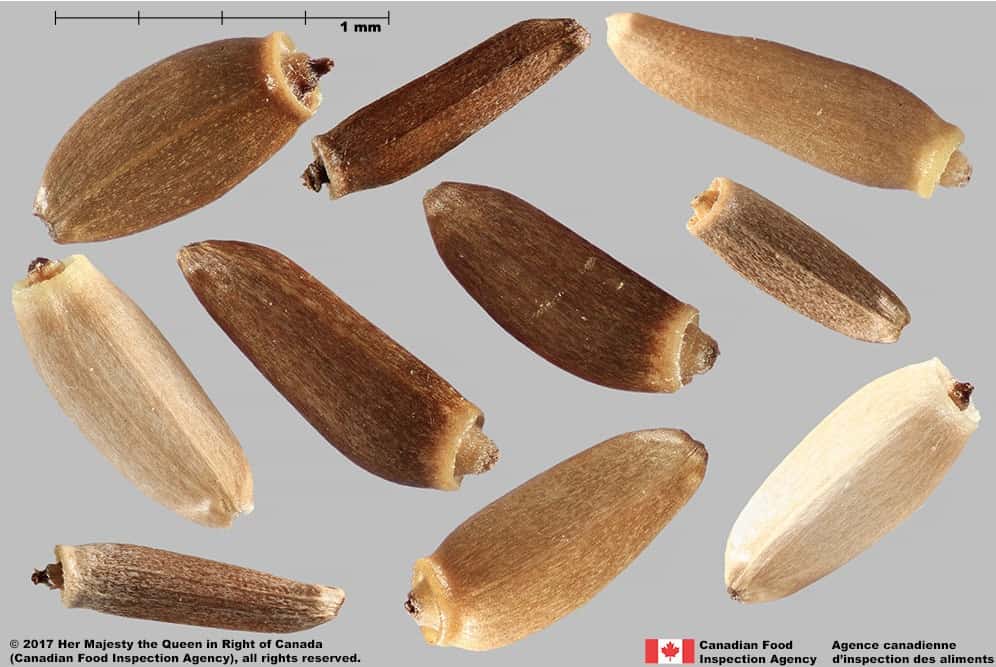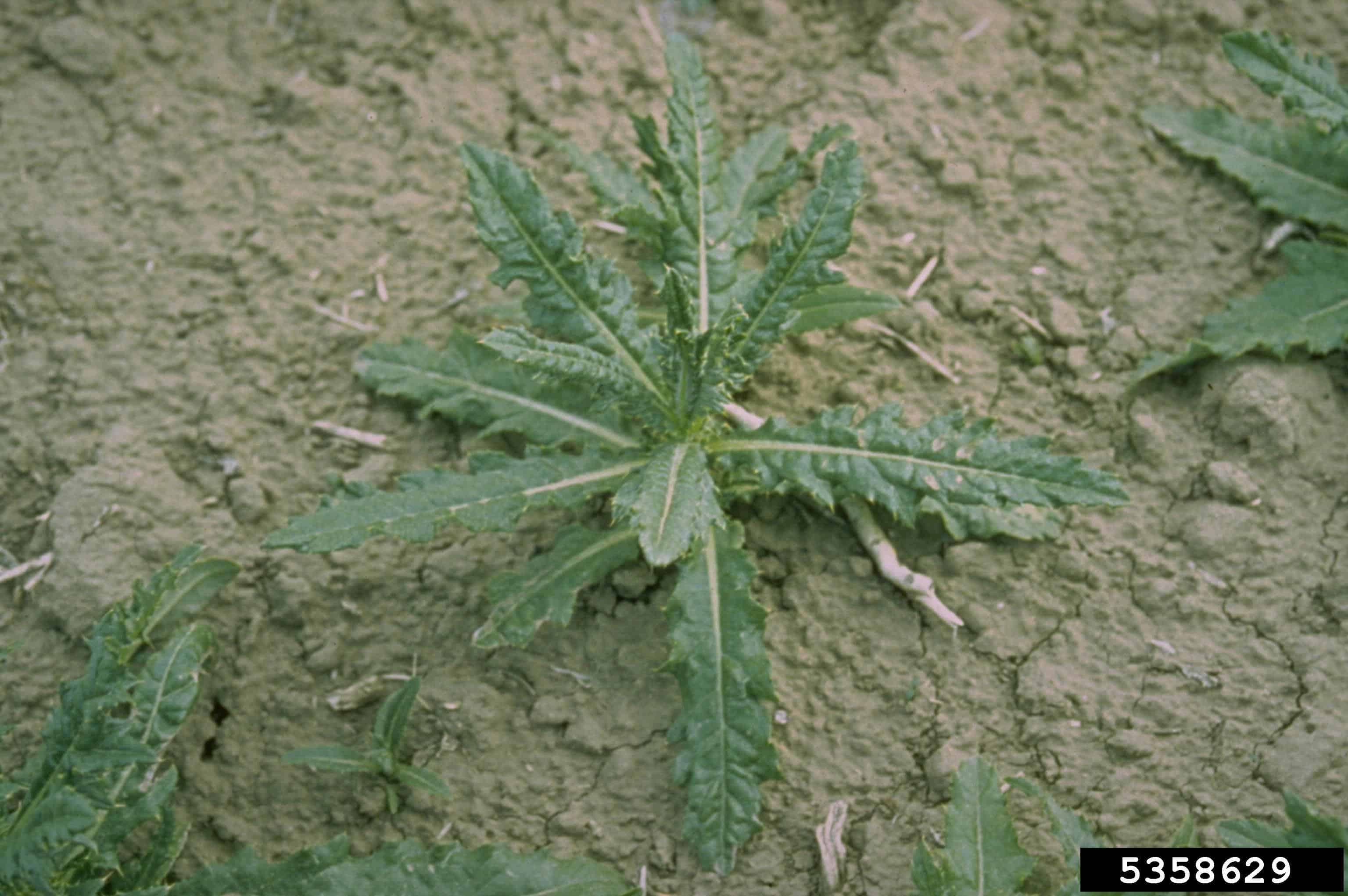Cirsium arvense
Overview
Aperçu
Regulation :
Remarques Réglementation:
- CFIA Weed Seeds Order - Class 2: Primary Noxious Weed Seeds
Regulation Notes:
Distribution :
Répartition :
Native to most of Europe and temperate Asia to as far south as India and Nepal. Introduced to North America, Argentina, Chile, Iceland, Greenland, South Africa, Australia and New Zealand (USDA-ARS 2020). In Canada, occurs in all provinces and territories except Nunavut (Brouillet et al. 2010+).
Habitat and Crop Association :
Habitat et Cultures Associées :
Cultivated fields, old fields, gardens, lawns, pastures, fence lines, shores, thickets, open forests, roadsides, railway lines and other disturbed areas (Darbyshire 2003). Infests crops including Triticum aestivum (wheat), Zea mays (corn), Pisum sativum (peas), Phaseolus vulgaris (beans), Beta vulgaris subsp. vulgaris (sugar beets) and Solanum tuberosum (potatoes), as well as pastures and rangelands (Moore 1975).
Economic Use, cultivation area, and Weed Association :
Utilisation économique, zone de culture et association de mauvaises herbes :
Duration of Life Cycle :
Durée du cycle vital:
Perennial
Dispersal Unit Type :
Type d’unité de dispersion :
Achene
General Information
RENSEIGNEMENTS GÉNÉRAUX
Cirsium arvense was likely introduced as a contaminant of crop seed in the late 18th century (Moore 1975). Cirsium arvense grows over a wide range of habitats and elevations, preferring rich loam soils (BC MAFF 2002).
Seed production averages 1,500 seeds per plant, but these remain viable for only a few years (BC MAFF 2002). The plant also produces deep creeping rhizomes that allow it to survive below normal tillage depths (Royer and Dickinson 1999).
.
Cirsium arvense infestation (Alec McClay, McClay Ecoscience, Bugwood.org)
Identification
Identification
-
Achene
Size
- Achene length*: 2.9 – 4.6 mm; width: 0.9-1.8 mm
*Note: minimum and maximum of 20 achenes in a normal range of this species using specimen measurement (ISMA 2020)
Shape
- Oblong or elongated oval shaped, straight to slightly curved longitudinally, compressed, one end narrow and the other wide and truncate
Surface Texture
- Achene surface striate, with thin longitudinal grooves
Colour
- Achene dull or shiny straw yellow, light or medium brown
Other Features
Pappus
- Immature achenes can have a feather-like pappus
Achene end with pappus
- Thin style remnant in the center of the truncate end, appearing like a peg
- Narrow, light brown or straw yellow collar around the truncate end of the achene

Canada thistle (Cirsium arvense); achenes





-
Seed
Size
- Seed is similar to achene size
Shape
- Seed is oblong, truncate at one end
Surface Texture
- Seed is smooth
Colour
- Seed is orange
Other Features
- A thin, translucent, flexible seed coat loosely surrounds the seed
-
Embryo
Size
- Embryo fills the seed
Shape
- Embryo is spatulate, axial position
Endosperm
- Endosperm absent, nutritive tissue stored in the cotyledons
Other Features
- Cotyledons are oily and soft-textured
Identification Tips
CONSEILS POUR L’IDENTIFICATION
Achenes of Cirsium arvense are more narrow than other thistles, with a dull or shiny colour, a thin central peg and lack of a surface pattern.

Canada thistle (Cirsium arvense); achenes




Additional Botany Information
AUTRES RENSEIGNEMENTS BOTANIQUES
Flowers/Inflorescence
- Canada thistle is the only species of thistle in North America that grows as separate male and female plants (Moore 1975)
- The flower heads are dimorphic; female flower heads are flask-shaped during flowering and will elongate up to 20.0-25.0 mm long and widen during seeding (Lloyd and Myall 1976)
- Male flower heads are shorter; approximately 15.0 mm long at maturity, and remain constricted at the top (Lloyd and Myall 1976)
- The overlapping, spine-tipped involucral bracts that surround the flower head are identifying features of Canada thistle flower or seed heads (Moore 1975).
- Dried heads of Canada thistle may be found as impurities in grains. They are generally small (width: 10.0 – 20.0 mm, FNA 1993+), and either globose or oblong-shaped
- These dried heads may be empty, or contain aborted, immature or mature achenes

Cirsium arvense flowers (Mary Ellen (Mel) Harte, Bugwood.org)





Similar Species
ESPÈCES SEMBLABLES
Similar species are based on a study of seed morphology of various species, and those with similar dispersal units are identified. The study is limited by physical specimen and literature availability at the time of examination, and possibly impacted by the subjectivity of the authors based on their knowledge and experience. Providing similar species information for seed identification is to make users aware of similarities that could possibly result in misidentification.
Carduus nutans L. (nodding thistle)
C. nutans achenes can be smaller than C. arvense (length*: 2.3 – 3.7 mm; width 0.9 – 1.5 mm). C. nutans achenes have a smooth, varnish-like surface with darker longitudinal striations and irregular transverse stripes, while the achenes of C. arvense have a grooved striate texture without transverse stripes.
The style remnant is thicker and wider in C. nutans. The immature achenes of nodding thistle have a pappus with simple hairs and C. arvense has feather-like hairs.
The flower heads of C. nutans are larger than C. arvense (width: 20.0 – 70.0 mm; FNA 1993+), and the hairy involucral bracts curl away from the flower head (FNA 1993+).
*Note: minimum and maximum of 20 achenes in a normal range of this species using image measurement (ISMA 2020)
Click to select species
Cliquez pour sélectionner les espèces

Carduus nutans
Comparison Window
Fenêtre de comparaison
MAIN SPECIES
ESPÈCES PRINCIPALES
Cirsium arvense

Cirsium arvense
Asteraceae
Canada thistle (Cirsium arvense); achenes
MAIN SPECIES
ESPÈCES PRINCIPALES
Cirsium arvense

Cirsium arvense
Asteraceae
Canada thistle (Cirsium arvense); achene
MAIN SPECIES
ESPÈCES PRINCIPALES
Cirsium arvense

Cirsium arvense
Asteraceae
Canada thistle (Cirsium arvense) top of achene
MAIN SPECIES
ESPÈCES PRINCIPALES
Cirsium arvense

Cirsium arvense
Asteraceae
Canada thistle (Cirsium arvense) achene, top-down view
MAIN SPECIES
ESPÈCES PRINCIPALES
Cirsium arvense

Cirsium arvense
Asteraceae
Canada thistle (Cirsium arvense); deformed achenes
SIMILAR SPECIES
ESPÈCES SEMBLABLES
Carduus nutans

Carduus nutans
Asteraceae
Nodding thistle (Carduus nutans) achenes
SIMILAR SPECIES
ESPÈCES SEMBLABLES
Carduus nutans

Carduus nutans
Asteraceae
Nodding thistle (Carduus nutans) achenes
SIMILAR SPECIES
ESPÈCES SEMBLABLES
Carduus nutans

Carduus nutans
Asteraceae
Nodding thistle (Carduus nutans) achene
SIMILAR SPECIES
ESPÈCES SEMBLABLES
Carduus nutans

Carduus nutans
Asteraceae
Nodding thistle (Carduus nutans) achene
SIMILAR SPECIES
ESPÈCES SEMBLABLES
Carduus nutans

Carduus nutans
Asteraceae
Nodding thistle (Carduus nutans) top of achene
SIMILAR SPECIES
ESPÈCES SEMBLABLES
Carduus nutans

Carduus nutans
Asteraceae
Nodding thistle (Carduus nutans) bottom of achene
Need ID Help?
Besoin d’aide pour l’identification?
Reference(s)
Référence(s)
British Columbia Ministry of Agriculture, Food and Fisheries (BC MAFF). 2002. Guide to weeds in British Columbia. Open Learning Agency, Burnaby, British Columbia, Canada. 195 pp.
Brouillet, L., Coursol, F., Meades, S. J., Favreau, M., Anions, M., Bélisle, P. and Desmet, P. 2010+. VASCAN, the database of vascular plants of Canada. http://data.canadensys.net/vascan/ Accessed November 23, 2020.
Centre for Agriculture and Bioscience International (CABI). 2020. Invasive Species Compendium, CAB International, Wallingford, UK. https://www.cabidigitallibrary.org/journal/cabicompendium Accessed November 23, 2020
Darbyshire, S. J. 2003. Inventory of Canadian Agricultural Weeds. Agriculture and Agri-Food Canada, Research Branch. Ottawa, ON.
Flora of North America (FNA) Editorial Committee, eds. 1993+. Flora of North America North of Mexico [Online]. 22+ vols. New York and Oxford. http://beta.floranorthamerica.org. Accessed December 29, 2022.
Global Biodiversity Information Facility (GBIF) Secretariat. 2022. https://doi.org/10.15468/39omei Accessed via https://www.gbif.org/species/3113414 Accessed December 29, 2022.
Government of Canada (GC). 2016. Canadian Weed Seeds Order. https://laws-lois.justice.gc.ca/eng/regulations/SOR-2016-93/page-2.html (English) https://laws-lois.justice.gc.ca/fra/reglements/DORS-2016-93/page-2.html (French)
International Seed Morphology Association (ISMA). 2020. Method for Seed Size Measurement. Version 1.0. ISMA Publication Guide. https://www.idseed.org/authors/details/method_for_seed_size_measurement.html
Lloyd, D.G and A.J. Myall. 1976. Sexual dimorphism in Cirsium arvense (L.) Scop. Annals of Botany 40: 115-123.
Moore, R. J. 1975. The biology of Canadian weeds. 13. Cirsium arvense (L.) Scop. Canadian Journal of Botany 55: 1033–1048.
Royer, F. and Dickinson, R. 1999. Weeds of Canada and the Northern United States. The University of Alberta Press/Lone Pine Publishing, Edmonton, AB. 434 pp.
U.S. Department of Agriculture-Agricultural Research Services (USDA-ARS). 2020. Germplasm Resources Information Network (GRIN), https://npgsweb.ars-grin.gov/gringlobal/taxon/taxonomysimple.aspx Accessed November 23. 2020.




